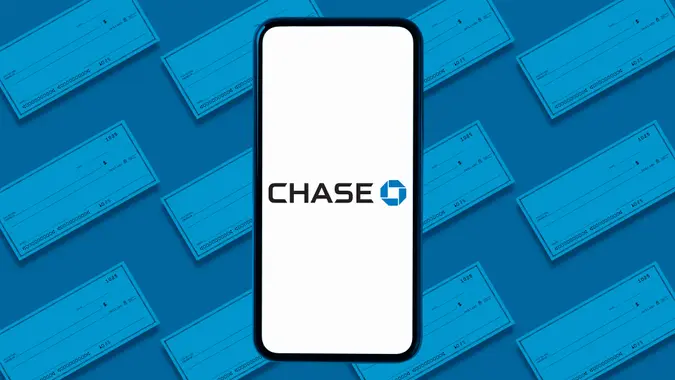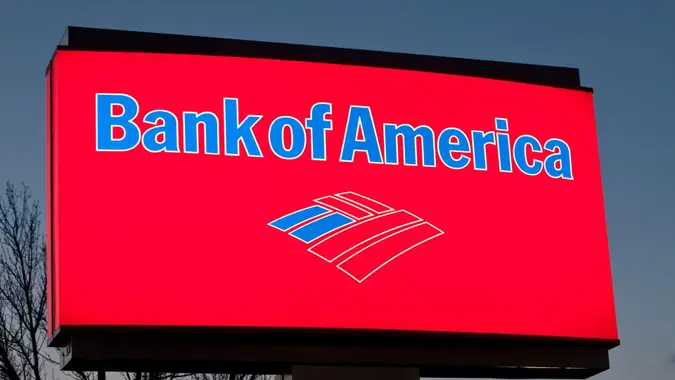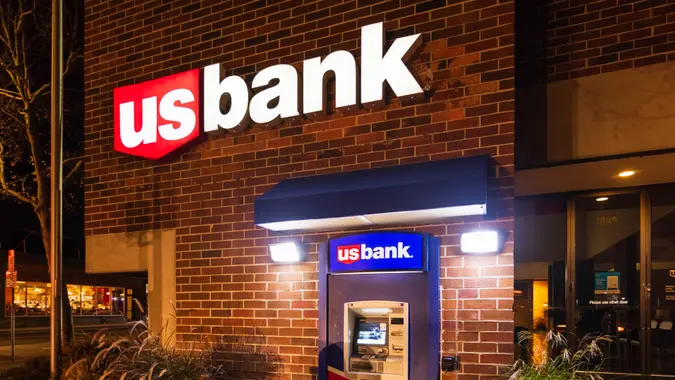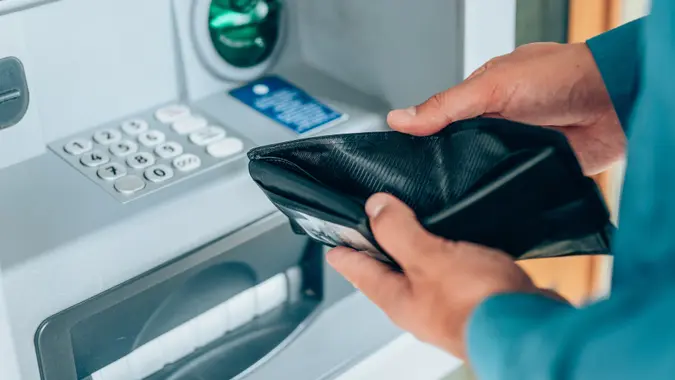U.S. Bank Checking Accounts

Commitment to Our Readers
GOBankingRates' editorial team is committed to bringing you unbiased reviews and information. We use data-driven methodologies to evaluate financial products and services - our reviews and ratings are not influenced by advertisers. You can read more about our editorial guidelines and our products and services review methodology.

20 Years
Helping You Live Richer

Reviewed
by Experts

Trusted by
Millions of Readers
With over 2,000 branches across 26 states, U.S. Bank has maintained a healthy footprint in the United States and beyond since its inception in 1893. One of its primary offerings is a checking account.
U.S. Bank offers two types of checking accounts — the Safe Debit Checking Account and the Smartly Checking Account. Although there are some differences between the accounts, each checking account is:
Insured by the FDIC
Most accounts at U.S. Bank are FDIC insured “to the maximum allowed by law” according to the financial institution. Each account is insured up to $250,000 “per depositor, per ownership category, per FDIC-insured institution.”
Accessible with Digital Tools
All U.S. Bank customers have access to the U.S. Bank digital app, which provides different ways to manage your account from a mobile device including mobile check deposits, contactless payments, automated bill pay, Zelle instant transfers, and you can set account alerts and reminders.
Young People-Friendly
Joint checking accounts for minors are a great opportunity for young people to start their financial education early. Both checking account options at U.S. Bank give you the option to open a joint account that enjoys special benefits with a minor between 13 and 17 years old. Once a young person turns 18, they are eligible to open a checking account on their own that receives special benefits until they turn 24.
Supported by a Large National ATM Network
U.S. Bank has a large network of ATMs around the country, making it easy for you to bank on the go. U.S. Bank ATMs allow you to manage your account by depositing cash and checks, making withdrawals, checking your balance, transferring money between accounts, and more.
U.S. Bank Checking Account Options
You can’t go wrong with either of the checking account options U.S. Bank offers, but your needs may make you feel more called to one than the other.
The Safe Debit Checking Account is a check-free, no-frills debit account for customers who want a simple, streamlined checking experience. The Smartly Checking Account offers the ability for customers to grow their money securely with a variable APR while still having access to funds. Each option is a solid choice and will serve new and experienced customers well.
| Account Name | APY | Minimum Deposit | Monthly Fee | Account Minimum | Overdraft Protection | Direct Deposit |
|---|---|---|---|---|---|---|
| Smartly Checking | Variable | $25 | $6.95 | Average account balance of $1500 or greater | Yes | Yes |
| Safe Debit | None | $25 | $4.95 | No | No | Yes |
U.S. Bank Smartly Checking Account
The U.S. Bank Smartly Checking Account is a great option for people who want a flexible checking experience with lots of added benefits, and you can open one online in just a few minutes with a minimum deposit of $25.
Once you open an account, you can enroll in the U.S. Bank Smart Rewards program, an account balance-based four-tiered program that offers additional benefits like:
- Maintenance fee waivers.
- Overdraft fee reimbursement.
- Increased APYs.
If you have young ones between the ages of 13 and 24, U.S. Bank offers a Greenlight account that can help them learn how to manage their money with some parental controls available.
They’ll have overdraft services like overdraft protection and an overdraft fee forgiveness program.
The Greenlight debit card also comes with an app that makes learning how to manage money fun with “goal-setting games, money-earning chores,” and more according to the U.S. Bank website.
Smartly Checking Account Fees
The Smartly Checking account comes with a standard monthly maintenance fee of $6.95. There are several opportunities to have these fees waived, though — through being part of a special customer group or meeting qualifications in the Smart Rewards programs.
To have your maintenance fees waived:
- Be part of a special customer group. These groups include youth aged 13 to 24, seniors 65 and older and military personnel.
- Meet qualifications in the Smart Rewards program.
- Have more than $1,000 in direct deposits.
- Have a qualifying U.S. Bank credit card.
- Maintain an average monthly balance of at least $1,500.
The Smartly checking account does offer overdraft protection and reimbursement in some cases. The Smartly checking debit card will incur fees at non-U.S. Bank ATMs but may be eligible for a waiver through the Smart Rewards program.
U.S. Bank Safe Debit Account
The U.S. Bank Safe Debit account is a more streamlined, check-free banking experience. With this account, customers receive a U.S. Bank Visa debit card and can access the U.S. Bank mobile app for financial management on the go.
The account does not provide overdraft services, so purchases made without the full dollar amount available in your account to cover it will decline. If, for some reason, a purchase does overdraft there will be no fee associated.
Bank Safe Debit Account Fees
In 2016, Bank On certified the U.S. Bank Safe Debit Account as a low-cost, low-fee account for meeting National Account Standards. That being said, low-fee does not mean no-fee.
To open a Safe Debit Account, there is a $25 minimum deposit. The account also comes with an un-waiverable $4.95 monthly maintenance fee. Although the Smartly Checking Account maintenance fee is waiverable, there is a monthly minimum balance requirement. The Safe Debit Account has no minimum balance requirement. So, there is a trade off there if you’re deciding between the two accounts.
While the Safe Debit Account may seem a bit restrictive, that’s what makes it a great option account option. Customers trying to build a healthy banking habit — like young people or habitual over spenders — the restrictions act more like bumper railings in bowling. The Safe Debit Account is a controlled environment to help customers remain financially healthy.
FAQ
Here are some Frequently Asked Questions about checking accounts at U.S. Bank:- Is there a free checking account in U.S. Bank?
- There are no free checking accounts at U.S. Bank. The Smartly Checking Account and the Safe Debit Account both require a minimum $25 deposit. The Smartly Checking Account also comes with a $6.95 monthly maintenance fee, and the Safe Debit Account comes with a $4.95 monthly maintenance fee. Only the Smartly Checking Account's fee is eligible for a waiver.
- What is the $300 checking bonus at U.S. Bank?
- This offer has expired, but you can see all of the details for it here. When you opened a U.S. Bank checking account by June 27, 2024, you could have been eligible for a cash bonus. To be eligible for the cash bonus, you must have:
- Opened a Smartly Checking Account by June 27, 2024 with at least a $25 deposit.
- Enrolled in either the U.S. Bank online banking program or mobile app.
- Made at least two direct deposits.
- The total combined amount of your deposits determined your bonus amount. To qualify:
- $100 bonus: Deposit between $3,000 and $4,999.99.
- $300 bonus: Deposit between $$5,000 and $9,999.99.
- $500 bonus: Deposit $10,000 or more.
- This offer has expired, but you can see all of the details for it here. When you opened a U.S. Bank checking account by June 27, 2024, you could have been eligible for a cash bonus. To be eligible for the cash bonus, you must have:
- What is the minimum opening balance for a checking account with U.S. Bank?
- The minimum opening balance for all checking accounts at U.S. Bank is $25
Editorial Note: This content is not provided by any entity covered in this article. Any opinions, analyses, reviews, ratings or recommendations expressed in this article are those of the author alone and have not been reviewed, approved or otherwise endorsed by any entity named in this article.
This article was last updated June 25, 2024.
 Written by
Written by  Edited by
Edited by 























